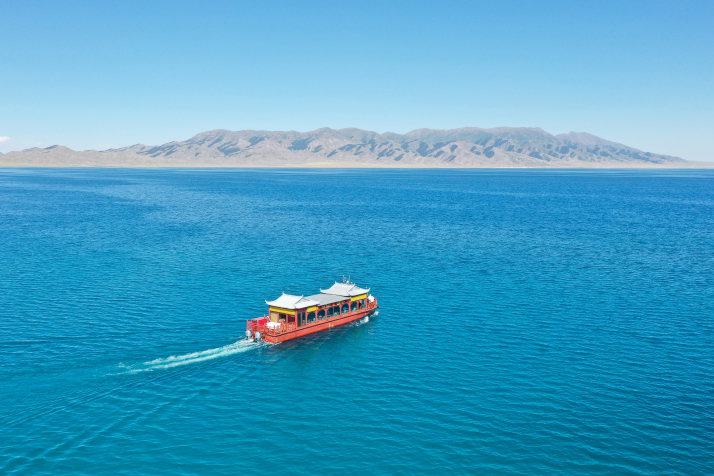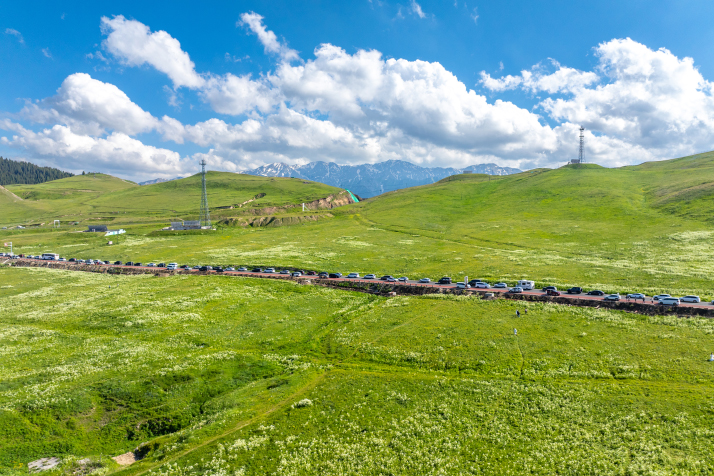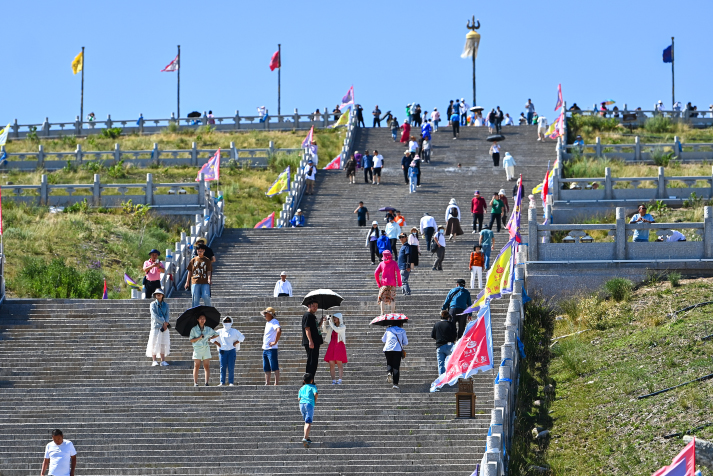| Xinjiang Today |
| Everyone's responsibility | |
|
|
 A sightseeing boat cruises on Sayram Lake in July 2023 (XINHUA)
Sayram Lake, Xinjiang's highest and largest alpine water body with a rich and diverse ecosystem comprising wetlands, grasslands, meadows and forests, is a stunning destination that draws crowds of self-driving campers every summer to connect with nature.
Decades ago, a circular road was built around the lake at a cost of over 50 million yuan ($7 million) so that visitors and their cars would not damage the surrounding grassland and vegetation. Yet, that harmony was disrupted this June by a single reckless driver whose vehicle went off-road, plunging into the grassland and mowing down the vegetation. When this became known, it sparked widespread anger online and offline, with people condemning the vandalism and calling for stringent punishment for the driver. After an on-site investigation, it was assessed that nearly 1 hectare of grassland had been damaged. The driver was slapped with a hefty fine and also ordered to take part in the vegetation restoration work. The impact of the incident continues to ripple. Online, it has become a cautionary tale, reminding travelers to respect Xinjiang's beautiful but fragile environment. It is also a wake-up call for the local authorities to strengthen patrols and ecological protection measures.  A grassland by Sayram Lake in June 2024 (VCG)
Striking a balance Xinjiang is a region with a unique geography. Here deserts, gravel plains and green oases exist side by side, making environmental protection and ecological balance essential for sustainable development. For several decades, Xinjiang has been promoting programs to convert farmland back to forests and grasslands, restore degraded pastures, and reduce the grazing pressure on the grassland. China's grassland ecosystem is among the most fragile in the world. In the past, it was severely degraded both due to natural causes—like wind and water erosion, sandstorms, and rodent and insect infestations—and human activities such as overgrazing and reckless land use. In some regions, agriculture and infrastructure development were prioritized at the expense of ecological preservation, which exacerbated grassland degradation. This has been an acute challenge in Xinjiang too. However, things began to change after the 18th National Congress of the Communist Party of China in 2012. With increasing attention to ecological protection, investment in grassland conservation has increased considerably, and the focus has shifted from economic goals to a more balanced approach that prioritizes the ecology alongside economic and social development. Overgrazing and illegal excavation have declined. Initiatives like building seed bases for forage grass and fencing pastures have brought about notable environmental, economic and social benefits. Today, herders have been taught livestock management and how to use pasture land sustainably. Where grazing has been banned, reward and subsidy programs have been rolled out to support herders and strike a balance between people, livestocks and grassland capacity. This has helped reverse grassland degradation and improved the ecosystem. The Sayram Lake scenic area is a prime example. Here, according to regulations, the grassland has to remain idle for a certain period and grazing is done by rotation. In more than 28,300 hectares around the lake, grazing has been banned. The core of the lake area has seen gradual restoration of vegetation, pollution caused by animal husbandry has been curbed, and the water quality of the lake has improved. To restore the area's primitive natural conditions and reduce sedimentation of the lake, more than 8,600 hectares of grassland have been rehabilitated, 35 km of the lake embankment have been covered with stones, and over 90 km of river valleys and gullies have been remediated. Green development is also reflected in the low-carbon tourism infrastructure. The sightseeing buses circling the lake run on electricity, the catamarans on the lake are mainly wind-powered, supplemented by green electricity from renewable sources, and electric heating helps reduce carbon emissions.  Sayram Lake hosts ice and snow events in December 2024 (XINHUA)
Shared responsibility With the steady improvement of infrastructure, Xinjiang's intercity transportation network, consisting of highways, railways and flight routes—has become increasingly advanced. In 2024, the region received over 300 million tourist visits, a new record. Many visitors are left in awe by Xinjiang's natural beauty. That's why the reckless vehicle driving across protected grassland triggered such widespread public outrage. Why did it happen? One reason is that although the signage in the lake area and the tickets inform visitors what is permissible and what is not, they do not spell out the legal consequences of misdemeanors, especially damaging the grassland ecosystem. If the legal consequences are clearly explained, that would be a deterrent. This could be done by having regular AI-powered announcements in vulnerable areas while drone patrols could issue real-time warnings. Interactive displays simulating the process and cost of ecological restoration would also raise awareness about the "legal red lines." The concept that "protecting the environment is everyone's responsibility" has become common sense. The enforcement action taken after the Sayram Lake incident sets a valuable precedent. In future, those who cause damage would have to participate in grassland restoration and conservation work, reinforcing the idea that mistakes have real consequences and it is also the responsibility of the law breaker to put the matter right.  Tourists at the Sayram Lake scenic area in July 2023 (XINHUA)
Then there is the issue for managers of natural scenic areas across China: How to balance "openness" and "protection?" While ecological zones like Sayram Lake should be accessible to visitors to connect with nature, given its vulnerability, how can it be ensured that the area's carrying capacity is not breached? There could be short-term solutions like installing removable fences or eco-friendly walkways in core grassland areas, clearly marking the "accessible" and "protected" zones. The visitor flow can be controlled by using big data and making advanced reservations mandatory for self-driving visitors during peak seasons. Low-impact travel options like green shuttles or bicycles should be encouraged. Fines are not the answer to acts of vandalism. The long-term aim is to prevent further destructive actions. The Sayram Lake incident shows that besides stringent law enforcement, public awareness initiatives, especially those for raising legal literacy, are essential for effective protection. Ecological protection requires both firm enforcement to uphold the bottom line and soft influence to nurture public awareness. When every traveler becomes the guardian of natural beauty, under the protection of law and care from all, damaged grasslands will spring back to life. Comments to pengjiawei@cicgamericas.com |
|
||||||||||||||||||||||||||||
|